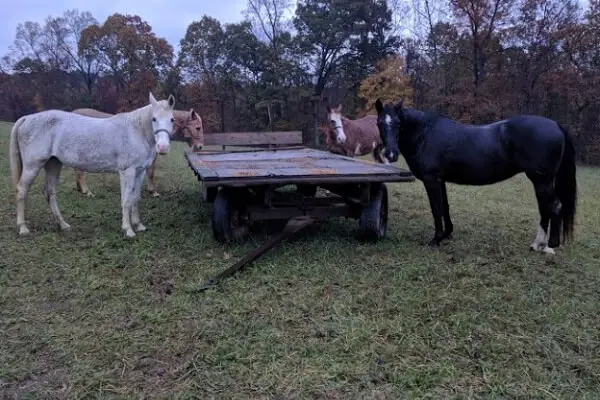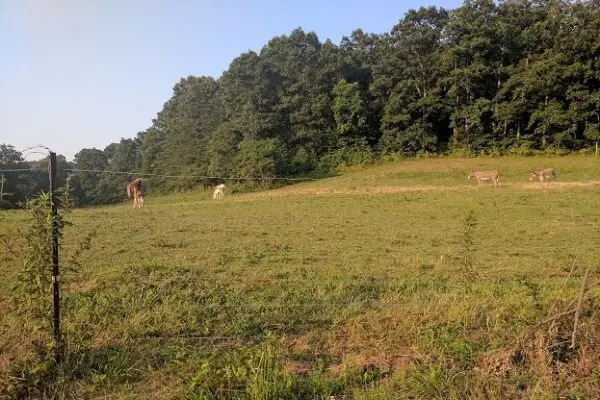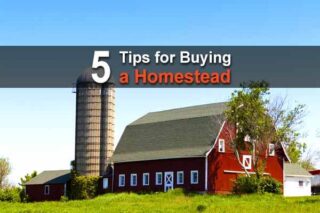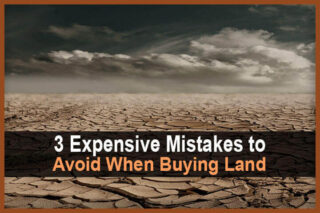Estimated reading time: 18 minutes
Do you yearn for your very own homestead but just can’t figure out how to afford it? You are not alone. Fortunately for you and tens of thousands of potential homesteaders and prepper retreat dreamers, the government might actually be here to help for once.
While “free land” for homesteading and farming doesn't really exist anymore, in spite of what some clickbait headlines claim, a plethora of low or no-money-down land grants and loans are readily available.
Want to save this post for later? Click Here to Pin It On Pinterest!
Find Your Dream Homestead
The first step in the process is to find the right parcel of land for your new homestead. How long this takes depends upon several factors. First, are you “loan ready”? What exactly that means is detailed below. Until you know how much of a loan a lender thinks you can afford and if the institution is willing to give you the funds, your homestead will remain a daydream dancing around your head while you browse real estate listings.
It took my husband and I three long years to find the right piece of land. We could have purchased some really nice land that met most of what we knew a sustainable homestead/survival retreat needed, but we were unwilling to settle for less than perfect.
After 13 U-Haul loads in the biggest trucks they make and countless pickup truck and SUV loads, we will surely spend our final days on this patch of dirt, and we knew that going in. There are starter homes, but rarely are there starter homesteads.
Once you find the right spot and cultivate, only the inability to maintain it will ever force a homesteader to move. So choose wisely when you buy the land and make sure you can afford not just the purchase price but also the property taxes and any home rehab or construction that needs to take place, as well as livestock and crop improvements.
Unlike a traditional country home buyer, a homesteader is looking for far more than beauty in a piece of land. For a homestead to be sustainable, it must have at least one natural water source, be partially wooded for hunting and firewood chopping purposes, have a decent quality of soil, as well as ground with suitable sunlight for growing crops and pasture if you plan on raising horses and cattle. Pigs, sheep, and goats can browse for their food in partially wooded areas and on lesser quality grass than cattle and horses.
Search for a real estate agent who is a land specialist and explain to him or her exactly what you plan on doing on the property. If possible, secure the services of an off-grid, homesteading, or survival real estate agent in your region to better ensure you have a representative who is well-versed in the self-reliant lifestyle.

The amount of land you want to purchase can often dictate what type of loan the property can qualify for when applying for either a government-backed or conventional loan.
Understanding Credit Scores And Debt – 9 Things You Should Know
Before you begin eagerly browsing the homesteading loans and land-grant offerings below and excitedly call your bank, make sure you are as loan ready as possible. You may have a long job history, earn a good income, and have no debt, but that does not mean a bank will offer you a loan. Thankfully, getting credit ready might not be as difficult as you think. Here are nine things you should know.
1. When a lender (including credit card carriers, cell phone companies, utility companies, cable and internet providers) checks your credit score, that is a “hard hit.” You want as few of these on your credit report as possible. It takes at least two years for them to “fall off” your report. Hard hits hurt your score because lenders view them as a customer who is either shopping around for money or a service after denials or someone who is securing too much credit at once and might not be able to fulfill their commitment once a bill comes due – or both.
2. You can check your credit score as often as you like without hurting your score (and should) because that is a “soft hit” which does not harm your score. With the exception of one or perhaps two (rules change annually) government loans, the minimum credit score required for loan approval is 640 – as of spring 2018.
3. Free credit score providers, like Credit Karma, offer an overview only of your score and the results may not be exactly what a lender will see. Typically, the scores you view after signing up for such a service can be up to 15 points off in either a positive or negative direction.
4. Once every 12 months you can request your complete and official credit score without a ding to your report.
5. The worst thing you can do is to have no debt whatsoever when going to apply for a loan or grant. When you don't have any open lines of credit, your score becomes stagnant and does not give a lender a history of payments to check. Lenders prefer (some require) two open lines of credit for a minimum of 12 months, but prefer at least two years, before approving any buyer for a loan.
6. The general rule of thumb is to never use more than 25 percent of your credit limit to keep your score in good standing – and climbing. Get a credit card, even a secured credit card, for a minimum of $200, charge $25 a month to it, then pay it off each month.
7. Secured credit cards and Fingerhut accounts are two of the most commonly and successfully used credit building tools for folks with no or bad credit. If you get turned down for a credit card, your score takes a hit.
8. If you have collection agency accounts opened on your credit report, they must be paid off before almost any loan is offered. Some collection agencies agree to remove a closed account after it is paid, others refuse to do so and only mark the debt as paid and closed and it remains on your report for two to seven years, preventing your score from increasing as much as it could if the debt were removed. If a collection agency agrees to remove a closed debt, get that information in writing BEFORE you make the payment.
9. Any charge-off or settlement agreement of any type will ding your credit score. Collection agencies often agree to settle for a lesser amount than what is owed. This will only benefit your score if the closed account is removed from your credit report. Closing the debt with a settlement for a lesser amount agreement is better than leaving the debt showing on the report, but again, it will keep your score down until it falls off the report several years later.
You must secure a home owner’s insurance policy for the property you purchase before the loan closing. The distance of the home from the road, the type of livestock you keep, how they will be used, and their ages are just a few of the questions which will determine what type of policy the property can receive. The breed of dogs you keep, if a creek has to be crossed to reach the home, and if a wood burning stove or propane heater will be used, also play a substantial role in securing the required insurance policy.
Debt To Income Ratios
Lenders use a debt to income formula to determine how much of a loan you can afford. They take your annual income and divide it by 12 to determine how much you earn per month. Typically, child support and alimony can count as income if the funds have been consistently received for a minimum of two years.
The bank will use the same formula to determine your monthly debt. Usually, utilities are not factored directly into the equation–many lenders estimate a standard amount for such expenses. But any other loan or credit card payments will be counted as debt.
Usually, a lender will not permit an applicant to garner a loan with a payment that puts their debt higher than 40 to 45 percent of their documented income.

The operation of a business on your homestead may influence the type of loan package you can qualify for when applying for either a government or conventional loan. In many cases, it will be to your advantage not to try to combine a homestead and business loan but to purchase the land first and then secure operational funds for a business separately. Government-backed loans and grants for agriculture-related businesses can help homesteaders set up an operation or service that allows them to make money from their land.
6 No And Low-Money-Down Loans For Homesteaders
1. Fannie Mae HomeReady Loan – This government-backed loan is only a few years old and features vastly reduced loan qualification requirements when compared to most government and conventional loans. It permits the buyer(s) to have a higher DTI than any other loan currently on the market. This loan, at least currently, can allow an applicant to have a lower than 640 credit score and to use non-conventional credit to supplement a thin credit file. Non-traditional credit could be a 12-month documented history of rent payments, rental furniture payments, car insurance payments, utility payments, child care payments, and cell phone payments.
The HomeReady loan also allows the income of non-borrower household members, whether they are related or not, to be factored into the loan for DTI purposes. A down payment as low as 3 grand could be all that is needed to apply for this loan. Land contract payments may be counted as equity paid toward the down payment. Income limits do not exist if the land is in a designated impoverished area. New manufactured homes qualify for a combo home and land purchase loan. You do not have to be a first time home buyer to take advantage of this loan program.
2. Beginning Farmers USDA Loan – This government-backed loan has a low-money-down (5 percent) feature with down payment assistance available. There is no income limit for inclusion in the program, but a maximum amount of acreage cap is involved. Currently, any agriculture land purchased must not exceed a specified acreage average based on other farm-type lands in the county. The loan amount cannot exceed $500,000 and the applicant must have 10 years experience working in a farm position to qualify. Your local Farm Service Agency (FSA) representative can help define what type of experience counts toward the requirement. Educational and non-professional experience could qualify.
3. National Sustainable Agriculture Coalition – This program offers down payment assistance to individuals applying for a loan through either the USDA Beginning Farmers or Socially Disadvantaged programs. Female farmers/homesteaders qualify to apply for the loan down payment assistance program.
4. Minority and Women Farmers and Ranchers – Applicants for this USDA loan program must have at least three documented years of working in the agricultural realm to qualify. A 5 percent down payment – or down payment assistance from the program noted above, can help applicants meet the qualifications for this loan opportunity.
5. FSA Operating Loan – This no or low-money-down government loan program grants up to $35,000 for agriculture start-up expenses. Some of the FSA loan projects and items homesteaders could use the funding to purchase include fencing, farm machinery, livestock, plants, seeds, and fertilizer.
6. USDA Rural Development – This government backed loan program also offers either no or very low-money-down loans for purchasing agriculture land. No income limits will disqualify you from applying, but currently, the homesteading land parcel must encompass a maximum of 20 acres.
Top 15 Agriculture Grants
Hobby farms will not likely qualify for any of these grants unless they have a research or education component. For government and tax purposes, a farm business can be extremely small scale and does not necessarily have to generate a profit – especially during the first two to five years.
There are no tax breaks for having hobby farms, but if you document the work you do on the land by hours, task, and dates, and record your expenses and income, even selling extra eggs, honey, horse boarding, firewood, and the animals bred on the property could count as a farm business.
Typically, at least one of the property owners has to be doing at least part-time work with the farm or homestead money-making endeavor for it to count as a business.
Agriculture Property Grants
1. Start2Farm – This government program was created through the United States Department of Agriculture (USDA) to help beginning farmers and ranchers buy land. There are currently no income or acreage limits pertaining to the program, but applicants must have less than a decade of agricultural experience to apply.
2. Organic Farming Research Foundation Grants – Once you own your very own homestead, you can apply for a grant through this association to garner funds to help start or enhance an organic growing, weed control, insect infestation, or livestock health operation.
3. Beginning Farmer and Rancher Development Program – Like its USDA land purchase counterpart, this program is also designed for applicants with less than 10 years of agriculture experience. Funds can be used to not only buy land but also purchase equipment and make improvements to a purchased property. Programs for urban farmers also exist within the program.
4. Organic Cost Share Program – This government program helps to cover the cost associated with garnering organic certification for a farm or homestead. Such certifications could help homesteaders set up an organic for-profit growing operation and garner a higher price for their certified organic harvest.
5. Sustainable Agriculture Research and Education (SARE) Grants – The grants offered via SARE are sometimes state specific and focus on sustainable agriculture. Forest farming – the growing of mushrooms and harvesting of ginseng, extending the growing season using low hoops and cold frames, are just a few of the small-scale business and research operations to which grant funding can be available.
6. Vermont Working Lands Enterprise Board – This state-specific grant awards grants up to $550,000 for Vermont residents who are using their land to help boost agricultural production in their local area. Funds can be used for a variety of purposes, including buying or enhancing farm buildings and equipment. This is just one example of many similar state-specific programs that your regional Farm Service Agency representative can help you discover and apply for after buying a homestead.
7. USDA Grant Programs – The Rural Development and Natural Resources Conservation agencies both offer grants to create or advance rural agriculture businesses and the growing of specific crops like rice in Louisiana, when waterfowl conservation practices are followed.
8. USDA Financial Assistance – Several programs within the federal government agency offer cost-defraying and annual stipends for the conservation and preservation of agricultural land and species. Some priority programs include the the Conservation Stewardship Program, the Environmental Quality Incentives Program to improve water quality and related issues on the land, and the Water Bank Program which aids waterfowl and migrating wildlife while protecting water quality and reducing both wind and soil erosion.
9. Farmers Market Promotion Grants – This program was created to help farmers garner exposure for their agriculture businesses and enhance local and regional consumption of goods. Agritourism activities such as trail rides, hands-on sustainable homesteading events, and similar non-crop cultivations are permitted to qualify for the advertising and branding grant program.
10. Specialty Crop Block Grant – Funding from these grants can be used by farmers and homesteaders to increase the market competitiveness of specialty crops. The agency defines specialty crops as dried nuts, fruits, vegetables, tree nuts, nursery crops, and horticulture.
11. FSA Farm Operations – This agriculture microloan is funded through the USDA and awards up to $35,000 to aid farmers with initial start-up expenses on an agriculture property. The funding can be used to purchase livestock, plants and seeds, farm machinery, farm vehicles, and fertilizer, for example. Selling the bounty from the harvest at a local farmer’s market, community event, or maybe at an on-site farm produce stand could meet the business requirements for this government program.
12. National Institute Of Food and Agriculture – This agency offers a wide array of agriculture grants. Many of the grants are for research and education purposes and can provide funding for experimenting with organic growing, farming tools for the disabled, sustainable agriculture, pest management, non-native crop growing, and related homesteading projects.
13. Natural Resource Conservation Service – The NRCS grants offered by this agency are largely designed to improve agriculture land. Eligible homesteading projects could include wildlife habitat preservation, irrigation system, soil improvement, the improvement and preservation of agricultural land, and the restoration of pasture and ranch land.
14. Farm Aid – Folks of a certain age can likely still remember the first time Willie Nelson, Neil Young, and John Mellencamp hosted the first televised concert to aid American farmers. The event is still going strong, with Nelson personally signing the checks that help farmers both large and small start, enhance, save, and protect their agricultural businesses.
15. Rural Action Farm to School – Farms and homesteads both large and small can become involved in the program and sell their produce to local schools. In some areas, like the Farm Aid program funded in Athens, Ohio, farmers can use an agricultural food hub facility with a certified kitchen to prepare and can their goods and sell them to stores or online, use storage space and a walk-in cooler for their in-process harvested goods, and culinary tools to avoid the high cost of purchasing the equipment and jumping through endless government hoops that govern the sale of processed produce.
Making and Saving Money On The Homestead
Saving up the money necessary to put together the small down payment required for the loans noted above may mean giving up some luxuries for 6 to 12 months – and if you are fortunate enough to get a tax refund, applying all of it towards the down payment, as well.
Think in $5s and $10s and not hundreds or thousands when saving money to put towards your down payment and homesteading creation plans. Every dollar saved gets you a little bit closer to achieving your dream.
Top 10 Ways To Save Money
1. Skip dinner at restaurants and take out meals.
2. Take a “staycation” instead of a vacation or visit state parks and other free day trips instead of going to the beach this year.
3. Cut back on the number of cable channels you subscribe to and eliminate Netflix and similar streaming services that carry a fee.
4. Buy food in bulk and start growing more of your own groceries where you live now. Use container and vertical gardening to grow your own food if you currently live in a small space. Replace decorative flowers with edible landscaping. Purchase as many chickens as allowed at your current residence and learn how to care for them and collect their eggs.
5. Carpool to work and other activities to save money on gas.
6. You can live without air conditioning; you really can. Conserve electricity and water as much as possible to cut down on utility bills.
7. Replace extravagant birthday parties and Christmas presents with just a single meaningful present and homemade gifts. With some planning, a little bit of creativity, and a few hours of browsing Pinterest, you are sure to find inspiration for your homemade gifts.
8. Make seemingly essential purchases wisely. Look for sales when buying school supplies and clothing, don’t be afraid to hit yard sales for some gently used garments other children have outgrown or for new work clothes for you and your spouse. Fix clothing that is less than perfect.
9. Use coupons when going to the store. Some grocery chains have double or triple coupon days. Plan ahead when buying items you cannot grow yourself. Experienced couponers sometimes walk away paying nothing at the checkout counter.
10. Make your own natural cleaning and hygiene products. Making your own deodorant, shampoo, toothpaste, etc. is really fun and better for your family because only natural ingredients are used.
Top 15 Ways To Make Money on The Homestead
1. Breeding – Focus your breeding efforts on animals in demand in your region, poultry that is not readily available, like guineas, and heritage livestock to increase your potential profits.
2. Salvage – One man’s junk…. Selling old barn roof boards, slate roofing, old hinges, even rusted barbed wire and metal sheeting are sold for surprisingly high amounts to architectural salvage suppliers, online, and at flea markets.
3. Event Hosting – Rent out your barn for weddings and parties and pasture area for farm-to-table events.
4. Photo Sessions – Take nature and old barn backdrop photos for senior pictures, of children, pets, and wedding announcements – or rent your space to a professional photographer for the same purpose.
5. Produce Stand – Set up a simple roadside produce stand to sell what you grow, raise, and make on your homestead.
6. Recreation Rentals – Rent out space on your land for primitive camping, hunting, horseback, or ATV rides.
7. Herd Share – You can’t sell raw milk in most state, but you can sell a share of a cow or goat to others who come milk the animal themselves in exchange for the raw milk.
8. Beekeeping – Raise bees that you can rent to other farmers and homesteaders to pollinate their crops and sell the extra honey.
9. Boarding and Training – Rent out space and your services to train horses and farm dogs – tie this into a breeding herd and livestock guardian dog endeavor.
10. Compost – Sell your high quality composted soil at the local farmer’s market and to community members.
11. Online Selling – Open a store on a website like ETSY to sell your goat soap, grapevine, beeswax candles, dehydrated fruits and vegetables, jellies, collected nuts, etc.
12. Tree Tapping – There are about 15 trees you can tap for syrup. The supplies you need are inexpensive and the process is simple. Make and sell your own maple syrup both locally and online.
13. Workshops – Host on-site and online homesteading skills workshops to teach others how to be more self-reliant and put a few more dollars in your pocket at the same time.
14. Firewood – Cut and split firewood for sale from your farm side stand and at local campgrounds.
15. Hide Tanning – Learn how to tan your own hides so you can earn extra money selling the hides online and locally as well as making finished products from the leather after you butcher an animal.
The homesteading life is filled with days of both hard work and lots of joy. No matter how long it might take you to achieve your dream of owning your own small or large homestead, don’t give up. The first time you walk your land, a satisfied smile will appear on your face and you will know all of the sacrifices, time, and effort, were worth it!
Like this post? Don't Forget to Pin It On Pinterest!













Check out tax sales. A house with six acres, two barns, one with a milking parlor, went for $2,600 right down the road from me. Matter of fact I wish I had known about it ahead of time. Even I could swing that.